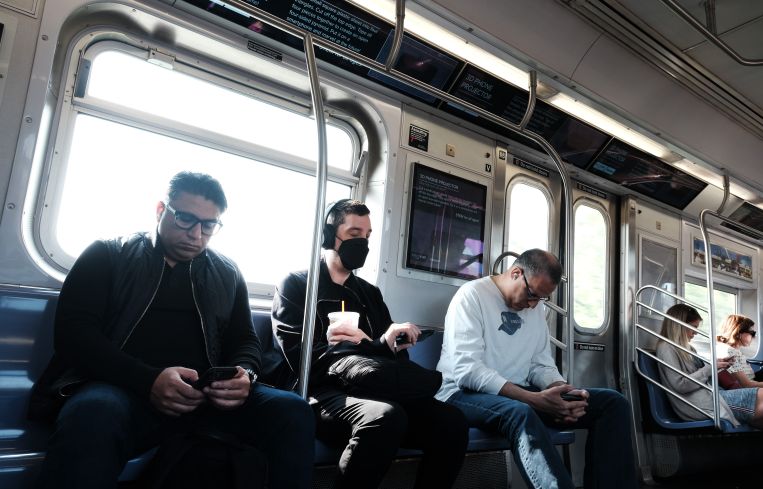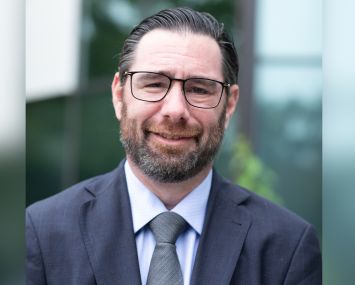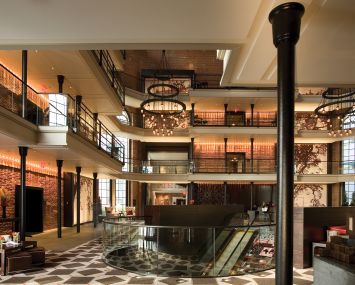New COVID Variants. A Return-to-Office Push. Sound Familiar?
New York City firms and office owners warily watch the numbers this September as medical professionals counsel caution and push vaccines
By Aaron Short September 7, 2023 6:57 am
reprints
New York businesses seeking to lure reluctant workers back to their offices encountered another obstacle toward the end of the summer as new coronavirus variants began to spread across the region.
A parade of companies in real estate, tech and finance have for several months been issuing mandates for office workers to show up more frequently once the summer unofficially ended. Amazon and Meta ordered employees to show up three days a week after Labor Day. BlackRock and Disney have brought workers back for four days, while Goldman Sachs, JPMorgan Chase, and the Durst Organizations have compelled most employees to come to their cubicles five days a week.
The private sector has a critical return-to-office booster in City Hall. One month into his tenure, Mayor Eric Adams chastised New Yorkers who “stay at home in [their] pajamas all day” and urged CEOs to drag their workers back to Gotham’s half-empty skyscrapers. He even sought to compel the city’s workforce back to downtown offices with limited success after agencies struggled to fill job openings and municipal labor unions pushed back.
On Sept. 4 — Labor Day — Adams said that concerns over coronavirus infections should not shape public policies around labor and employment.
“You know, we can’t live in this perpetual COVID,” the mayor said during a press conference announcing a new contract for Staten Island Ferry workers. “COVID is in our rearview mirror.”
Unfortunately, that isn’t the case. The number of new coronavirus cases has climbed steadily since Independence Day thanks to two new variants, known as EG.5 and BA.2.86, that were detected in the country earlier in the summer. Over a seven-day period in late August, the city reported an average of 69 cases per 100,000 people, up from 20 cases per 100,000 in early July, records show.
The average number of COVID-19 cases in late August over a seven-day period, 825, is still well below last summer’s figures when the average peaked at 4,730 cases in mid-July, and eons under the peak of the Omicron wave in early January 2022 when the seven-day average topped 40,000.
Business leaders are warily watching the number of cases the city reports.
“Obviously, the increase in COVID-19 cases makes it more difficult and more complicated to encourage return to the office,” said Kathy Wylde, president and CEO of the Partnership for New York City, which represents chief executives. “Hopefully public health advice is not going to force us back into pandemic-era protocols and policies, but if it does it would definitely discourage return to office.”
The new coronavirus variants are not likely to lead to a significant public health risk, physicians and epidemiologists say. But there’s no way to get an accurate read on how widespread COVID infections are since labs stopped reporting negative test results and tests have become far less prevalent since the Biden administration ended the national public health emergency in May. (The World Health Organization declared the pandemic over the same month.)
That could mean employees request more sick time this fall as kids return to school and people congregate indoors more frequently. A “mystery” bug already swept through the U.S. Open, sickening top tennis players, while first lady Jill Biden tested positive for COVID over Labor Day. (The Open did not require COVID tests or vaccinations.)
So far, employers aren’t changing their strategies to get butts into plush office chairs. New York’s workforce had been filling up Manhattan offices during the middle of the week at 73 percent of their pre-pandemic 2019 levels, according to the Real Estate Board of New York. At Hudson Yards, tenants have filled over 80 percent of its 28-acre building stock. A spokesperson for Related Companies, Hudson Yards’ primary owner, said COVID-19 has not dampened the back-to-work enthusiasm companies have this September.
“While Hudson Yards has the highest standards of commercial HVAC systems, including air filtration, at this point tenants are most concerned about making sure their employees are coming in to the best office space available,” Jon Weinstein, executive vice president of corporate communications at Related, said.
There are several ways that employers can reduce the risk of transmission while easing employee anxieties about working in an office during a COVID uptick. Having hygiene stations with plenty of hand sanitizer and soap is a start. So is normalizing mask wearing by supplying face coverings and making sure there is space available for people to eat outside instead of in an indoor cafeteria or at their desk.
“People might assume there’s a stigma, but creating a supportive environment does a lot of good,” Mitch Stripling, director of the Pandemic Response Institute at Columbia University, said. “You don’t know which side an employer’s thumb is on the scale if mask wearing is optional. We say, tell them, ‘We really support you wearing one, and here are some.’”
Employers can also encourage their workers to get vaccinated. Most Americans have had at least one COVID vaccine jab, although just 15 percent of adults eligible for the latest COVID booster shot received one as of December 2022, according to the CDC. A new round of vaccines is expected to be released in the coming weeks.
“This is a chance where leaders can lean into personal connections to improve vaccination,” Stripling said. “Even though the vast majority of people have been vaccinated, these numbers are startlingly low.”
Other measures are more expensive but still important. When the pandemic started, companies overhauled their air filtration systems to better sift viruses out of their office’s air flow. Some of those HVAC systems have started to break down, but Stripling recommends businesses invest in new filters at the same level of efficiency instead of going cheap with less expensive products.
Employees should also be open with their supervisors about disclosing their symptoms, getting a COVID-19 test, and requesting time off when they feel ill. Dr. Eric Ascher, a family medicine physician at Lenox Hill Hospital, recommends that patients who test positive stay home for five days and then wear masks in public for another five days after a negative test.
“If people are somewhat productive working from home in certain industries, that would keep illness out of the office and save the employer sick time for other employees in the long run,” Ascher said.
Health experts caution business leaders to remember that COVID-19 can affect different people in different ways, and that a one-size-fits-all policy may not be appropriate.
“Those who are older and medically vulnerable will always have more of a chance of severe illness than others,” Stripling said. “It’s important that businesses don’t make lightswitch decisions without considering those most vulnerable among them and figure out what they can do to take care of them.”


